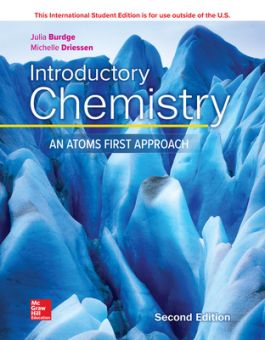Introductory Chemistry ISE
After purchasing your eBook, login to the McGraw Hill Bookshelf website and redeem the access code from your order confirmation email.
- Access your eBook online or offline
- Easily highlight and take notes
- Fully searchable content
- Syncs across platforms
NOTE: eBook purchase does not include Connect homework or adaptive SmartBook assignments
Chapter 1 Atoms and Elements
1.1 The Study of Chemistry
1.2 Atoms First
1.3 Subatomic Particles and the Nuclear Model of the Atom
1.4 Elements and the Periodic Table
1.5 Organization of the Periodic Table
1.6 Isotopes
1.7 Atomic Mass
Chapter 2 Electrons and the Periodic Table
2.1 The Nature of Light
2.2 The Bohr Atom
2.3 Atomic Orbitals
2.4 Electron Configurations
2.5 Electron Configurations and the Periodic Table
2.6 Periodic Trends
2.7 Ions: The Loss and Gain of Electrons
Chapter 3 Compounds and Chemical Bonds
3.1 Matter: Classification and Properties
3.2 Ionic Bonding and Binary Ionic Compounds
3.3 Naming Ions and Binary Ionic Compounds
3.4 Covalent Bonding and Molecules
3.5 Naming Binary Molecular Compounds
3.6 Covalent Bonding in Ionic Species: Polyatomic Ions
3.7 Acids
3.8 Substances in Review
Chapter 4 How Chemists Use Numbers
4.1 Units of Measurement
4.2 Scientific Notation
4.3 Significant Figures
4.4 Unit Conversion
4.5 Success in Introductory Chemistry Class
Chapter 5 The Mole and Chemical Formulas
5.1 Counting Atoms by Weighing
5.2 Counting Molecules by Weighing
5.3 Mass Percent Composition
5.4 Using Mass Percent Composition to Determine Empirical Formula
5.5 Using Empirical Formula and Molar Mass to Determine Molecular Formula
Chapter 6 Molecular Shape
6.1 Drawing Simple Lewis Structures
6.2 Lewis Structures Continued
6.3 Resonance Structures
6.4 Molecular Shape
6.5 Electronegativity & Polarity
6.6 Intermolecular Forces
Chapter 7 Solids, Liquids, and Phase Changes
7.1 General Properties of the Condensed Phases
7.2 Types of Solids
7.3 Physical Properties of Solids
7.4 Physical Properties of Liquids
7.5 Energy and Physical Changes
Chapter 8 Gases
8.1 Properties of Gases
8.2 Pressure
8.3 The Gas Equations
8.4 The Gas Laws
8.5 Gas Mixtures
Chapter 9 Physical Properties of Solutions
9.1 General Properties of Solutions
9.2 Aqueous Solubility
9.3 Solution Concentration
9.4 Solution Composition
9.5 Solution Preparation
9.6 Colligative Properties
Chapter 10 Chemical Reactions and Chemical Equations
10.1 Recognizing Chemical Reactions
10.2 Representing Chemical Reactions with Chemical Equations
10.3 Balancing Chemical Equations
10.4 Types of Chemical Reactions
10.5 Chemical Reactions and Energy
10.6 Chemical Reactions in Review
Chapter 11 Using Balanced Chemical Equations
11.1 Mole to Mole Conversions
11.2 Mass to Mass Conversions
11.3 Limitations on Reaction Yield
11.4 Aqueous Reactions
11.5 Gases in Chemical Reactions
11.6 Chemical Reactions and Heat
Chapter 12 Acids and Bases
12.1 Properties of Acids and Bases
12.2 Definitions of Acids and Bases
12.3 Water as an Acid; Water as a Base
12.4 Strong Acids and Bases
12.5 pH and pOH Scales
12.6 Weak Acids and Bases
12.7 Acid-Base Titrations
12.8 Buffers
Chapter 13 Equilibrium
13.1 Reaction Rates
13.2 Chemical Equilibrium
13.3 Equilibrium Constants
13.4 Factors that Affect Equilibrium
Chapter 14 Organic Chemistry
14.1 Why Carbon is Different
14.2 Hydrocarbons
14.3 Isomers
14.4 Functional Groups
14.5 Alcohols and Ethers
14.6 Aldehydes & Ketones
14.7 Carboxylic Acids and Esters
14.8 Amines and Amides
14.9 Polymers
Chapter 15 Biochemistry
15.1 Biologically Important Molecules
15.2 Lipids
15.3 Proteins
15.4 Carbohydrates
15.5 Nucleic Acids
Chapter 16 Nuclear Chemistry
16.1 Radioactive Decay
16.2 Detection of Radiation and its Biological Effects
16.3 Dating using Radioactive Decay
16.4 Medical Applications of Radioactivity
16.5 Nuclear Fission and Nuclear Fusion
Chapter 17 Electrochemistry
17.1 Balancing Oxidation-Reduction Reactions using the Half-Reaction Method
17.2 Batteries
17.3 Corrosion
17.4 Electrolysis

